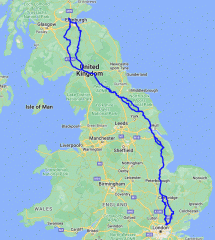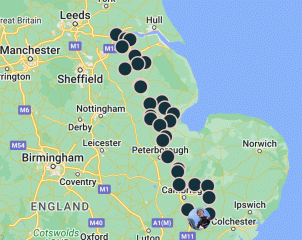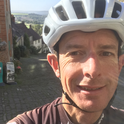London-Edinburgh-London 2022

The event has now finished. Click here to view the post-event page with photos and thoughts about the ride.
The 2021 edition of LEL was postponed by a year (due to COVID-19, of course), but in 2022 it is now on track for an August 7 start - finishing on August 12. There is a four-day option, to make the challenge even harder. The route is 1550km (963 miles), starting and finishing at Debden in north London; the northern-most point is Dunfermline (north of Edinburgh, over the Forth Bridge). I've plotted the 2022 LEL route (based on a 4-day schedule) to give myself a guide of hilliness and where facilities are located. I'll also use this to produce route cards for the whole journey.
Are you riding the event too, or helping out along the route? Let me know in the comments below! If you're riding, what sort of schedule are you planning? Hare or tortoise? What is on your equipment list?
Here's an interview I had with good friend and Iceni Velo clubmate Andrew Goodchild, where we explore the basics of the event and what I'm doing to prepare for it:
Schedule

The 125 hour option is 5 days + 4hrs and would mean almost 200 miles per day, whereas the 100 hour option is 4 days + 4hrs at around 230 miles per day. The big thing to decide is whether to be a hare or a tortoise, ie, ride faster and stop at night, or ride slower and keep the sleeps to a minimum.
Personally, I'm a hare. I should be able to manage the 100-hour target as I've ridden much more than 230 miles in a single day - but not back to back for four days, so the name of the game here is pacing. I'll aim to ride a fair bit slower than previous big-mile days, but still allow myself a solid 5 hours of sleep each night. If it goes to plan I'll be able to sleep at Malton (north of Hull), Dunfermline, and Malton again on the return leg.
I've been accepted in the sub-100-hrs group, so have a 5am start. If you happen to get a late start that isn't all bad. For example a 1pm start would mean only 9 hours of riding on the first day, getting you possibly as far as Louth. The next days could be Moffat, Barnard Castle and Spalding. So there'd be an extra overnight rest in there, and you would still reasonably expect to finish within the 100 hours.
Beating the schedule: It is possible that the first couple of days will be faster than expected (due to freshness and the greater likelihood of a tailwind), so I may reach Malton around 8pm - and may be back on the road by 3am or earlier. In this case I might be able to reach Innerleithen late on the second day - and Hessle or even Louth on the third day. This is obviously quite optimistic, but I should be prepared to ride beyond my expected overnight stop.
I will be using a power meter (and possibly a heart-rate monitor) to gauge my efforts, in particular to make sure that I'm not working too hard - especially in the first few hours of each day's riding. The big number to watch is power, but I shall also make sure that my cadence is nice and high, and that my "stroke energy" is nice and low. An HRM gives interesting data regarding stress on the cardiovascular system, but on the road it is influenced too much by things like digestion and air temperature to be monitored closely.
Dot-watching

There is an official "real-time" dotwatcher being used by a great many riders, but I've eschewed that in favour of a home-brewed tracker on my smartphone. It's free for anyone to use, and is available at cycling.routes.fun/dotwatch/LEL-2022.
Note that this is an "experimental" tool, and I won't provide any warranty on its use - but I have used it successfully on a few audaxes. Tracking is NOT automatic it requires the rider to manually add their location whenever they choose / remember. I did this deliberately to keep battery usage to a minimum.
For an example, see the Fenland Friends 2022. Comments on this tool would be gratefully received!
Ride companions
Basically, I'll be riding solo. I am however expecting (and hoping) to "buddy up" here and there throughout the journey as paths coincide. Whilst perfectly happy riding solo for long periods of time, I think that some informal companionship will help to break any spells of monotony.
Equipment
For maximum comfort and diversity of riding positions, I shall be on a road bike. So that's drop handlebars and a regular saddle, but with SPD pedals so that I can also walk normally when needed. I shall also fit clip-on aero bars, to give me increased efficiency on the flat stretches of the route. I'm well used to time trialing, and have never suffered back issues on the tri-bars, and in fact find that it is a more relaxing way to rest my upper body.
A word of warning with tri-bars though: don't just fit them and expect to just get an instant advantage. They take some getting used to, and bike control (whilst very good) is different. It's also important to know when not to use them, eg in gusting cross-winds and in steeper high-speed descents. Compounded with the increased fatigue of a long-distance multi-day event, you need to become experienced with using them safely.
I will carry a water bottle and a mini thermos flask in two regular bottle carriers, and will also have use a small bag on top of the top-tube to carry snacks. Despite intending on traveling light, I will most likely need to use a bike-packing saddlebag for tools and a minimal amount of spare clothes.
Drop bags and extras

Each drop bag:
- Cycling shorts & jersey
- Gloves / mitts (depending on weather forecast)
- USB mains charger
I may well decide to just use one drop bag (at Malton) to keep the logistics simpler. I will not use the postal service for returning drop bags, so will collect mine on the way home.
Extras to carry on-bike:
- Rain jacket
- Flip-flops
- Hand towel
- Toothbrush & toothpaste
- Lip balm, plasters, Sudocream, Deep heat, Ibuprofen gel
- Battery packs & cable
- Spare Garmin
- Chain lube
Clothing
I'm expecting considerable variations in conditions throughout the ride, so layers are everything. Base layer, short-sleeved jersey, gilet, shorts, arm-armers, leg-warmers and mitts will be my standard attire, plus a rain jacket & full-fingered gloves to hand if necessary. I probably won't bother with overshoes, but may carry a spare pair of socks. I'll have spare base layers, jerseys, shorts, socks and gloves in my drop bags, and maybe a spare pair of shoes in one of them.
Electronics
A big problem nowadays is how to keep the plethora of electronic gadgets charged up! I could go for a hub dynamo and be guaranteed of a power source, but that means a new wheel and does offer some drag on the ride. Also, I don't intend to do any night riding, so will be able to charge things up at my overnight stops. I will carry battery packs with me, charging devices with them on the move where possible, and just charge them up overnight. This plan should work as long as my drop bags contain mains USB chargers.
My on-bike devices are:
- iPhone
- Garmin
- Front camera
- Front light
- Rear light
Preparation
I'm not a stranger to day-long rides and to multi-day pacing, but not this volume of riding in a matter of days. So I have a bit of a plan to build up to the big event in August. There will be a steady diet of 200km audaxes of course, with the odd 300 and 400 thrown in as the daylight increases. I also plan to do a 600 in June. (I'd like to do a 600 in mid-July, but can't see a suitable one on the calendar.)
Sometime on Saturday I'll ride the start and finish roads just so that they aren't completely unfamiliar. Here's the route on Strava: LEL start & finish recce. This will probably in the evening, after I've helped at registration as part of Tim Decker's team.
The LEL Organisation
For official information, head over to the LEL website. It's also important that enough people step forward to volunteer, so please see how you can help!
A bit of insight into the hard work that goes on behind the scenes can be found in the Arrivee issue 155 (Spring 2022: Your LEL needs you. As a first-time rider (and never having volunteered either) I think it's very important to know what is - and isn't - in the scope of the volunteer's roles.
Getting advice
There's a dedicated section for LEL 2022 on yacf, plus chat about an unofficial route.
The official forum is the London Edinburgh London group on Facebook. Lots of interesting posts and questions, including information from the LEL organisers.
Previous experiences
To get some idea of what it's like to ride LEL, I've been reading back-issues of Arrivee. The Autumn 2017 edition and Autumn 2013 edition feature some good stories.
Grant Farm has an LEL 2021 route check when he rode the official route in 2021 after the event was postponed by a year. It's a great read, and gives good insights into surviving the big miles day after day.
Category: Cycling
2 Comments
Add your commentGet more out of your power meter!Free sign-up now
Recent Updates
03 Jan : Almost a blizzard at Blickling parkrun!03 Jan : Recreation
03 Jan : Audax: long-distance cycling
16 Dec : Cyclocross
07 Jul : Do It Yourself!
27 Oct : My Car Costs
13 Feb : Great Days Out
02 Sep : Nature
25 Nov : Piano for the Amateur
14 Nov : Measure
12 Oct : Simple Programming Exercises


For your July 600, you can always do a DIY - just pick a route & go for it. I do nearly all my training rides this way.
As for the 600k, I've opted for wind instead of hills: the Fenland Friends. I know the Fens fairly well, but it doesn't hurt to train for the exposure there in readiness for LEL's last leg!